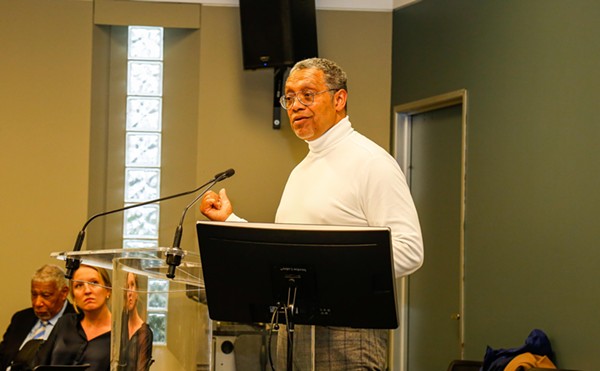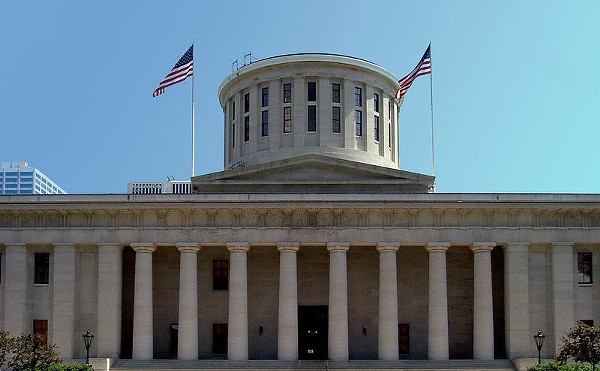Detective Phillip Habeeb waited outside the house for the right moment to make the early-morning entry, anxious to confront the 15-year-old boy he suspected of robbing a pizza deliveryman hours earlier. He and his partner, John Kraynik, were understandably upset, having arrested the same kid for a similar robbery six months earlier. They thought he'd learned his lesson during their last interrogation session, but apparently sterner and more aggressive measures were required. Armed with a search warrant, they waited for signs of movement in the house.
With time to burn, Habeeb called a radio dispatcher on his cell phone and chatted with her about the plan. The flirtatious dispatcher mused that if the detective was out of breath chasing the kid, "you know he's running." When the dispatcher suggested that he should "just shoot to kill," Habeeb replied, "Absolutely."
A few minutes later, Brandon McCloud lay dead in a pool of blood, shot 10 times in his own bedroom.
That was in 2005. In November, after four years of litigation, the Sixth Circuit Federal Appeals Court in Cincinnati threw out the wrongful-death civil-rights lawsuit we brought on behalf of his family, reversing a trial judge's earlier decision that a jury could find fault in the officers' actions and award compensation. The appeals court ruled that the shooters were entitled to immunity from the suit. In other words, we were denied our right to present the evidence to a jury of citizens to let them decide whether the detectives' actions were justified.
The ruling thus ended a bitter legal battle to obtain justice for the relatives, who can't accept that their loved one needed to be killed in a hail of bullets in his own home. Questions remain, especially how the legal process can prevent access to a jury trial when the facts are so compelling. And looming large is a systemic concern: Are the courts becoming insensitive to civil-rights cases?
As one of the family's lawyers, I believe the Brandon McCloud case provides some disturbing insights into these questions. Consider the following scenario:
During the early-morning hours of September 1, 2005, the two Cleveland detectives seemed to be on a mission to confront Brandon McCloud, convinced he had earlier threatened a pizza deliveryman with a knife near the southeast side of the city. They were perturbed that Brandon had gotten off easy in the last case, but now felt they didn't have enough evidence to arrest him. So they drove to the far west side of town, woke up a judge at 2:30 a.m. and obtained a search warrant by claiming they needed to find physical evidence. They could have waited until the morning to get the warrant and pick up Brandon. But they were eager for a face-to-face encounter before the sun came up.
At the house, Brandon's uncle, Melvin Chappell, had just woken and was getting ready for work at National City Bank. When he heard knocks shortly after 5 a.m., he answered the door, still in his shorts, and was startled to see two officers seeking entry. The detectives then rushed into the dark home without showing a warrant or first requesting to have Brandon roused. They proceeded upstairs, and within seconds, a rapid volley of gunfire and then shouts of "shots fired" pierced the quiet neighborhood.
Brandon's grandmother, Dorothy Chappell, heard the shots from the garage, where she was preparing to drive to her job as a health-care worker. Minutes later, Dorothy, who'd raised Brandon since he was a baby, was told her grandson was dead.
The detectives left the house and awaited the arrival of supervisors. According to a neighbor who was leaving for work, he overheard an anxious Habeeb on his cell phone saying, "It's a fatality! I just fucked up, I fucked up."
When the coroner and police investigators arrived, they discovered a horrific scene. Brandon was lying on his side in an open closet, bleeding from 10 gunshot wounds from the top of his head to his genital area. A steak knife lay near the body.
The next day, the president of the police union held a press conference and called Brandon a dangerous thug who'd lunged at the officers, who had no choice but to shoot. He even held up a picture of Brandon looking thuggish, a not-so-subtle message for the media. It wasn't until almost two weeks later that the detectives, accompanied by lawyers and union stewards, signed statements outlining their accounts of the event. They used the usual catch phrases — "I was afraid for my life"; "He moved as if to lunge"; "It all happened so fast" — but failed to address why they'd gone to the house at that time in the first place. Or why they rushed upstairs without announcing their presence. Or how Brandon posed a threat to them from inside a closet with a mattress between him and the armed detectives, holding the knife pointed up.
Still, the prosecutor, after only superficial review, made an initial determination the shooting was justified. Community activists were outraged. Rallies were held and questions were raised, but no answers were forthcoming.
Brandon's family was alarmed at the developing indifference in the investigation and feared a cover-up. They hired me, my partner Gordon Friedman and family attorney Ken Bossin to make sure the investigation was not compromised. In the days and months of the investigation, we discovered some profound and disturbing facts.
1. The detectives had not notified their supervisors about their intent to obtain a search warrant, a required step in the process.
2. The two police officers who arrived to secure the perimeter of the house, while the detectives entered, never heard any commands by the detectives announcing themselves as police officers prior to hearing the shots. Neither did Dorothy or Melvin Chappell.
3. In his statement, detective Habeeb said he did not know if Brandon would be home. But in his recorded cell phone call with the dispatcher, he said, "It looks like there's a light on in his bedroom."
4. A forensic expert found that some of the shots were fired while Brandon was in a seated position and defenseless.
5. An investigator with the Office of Professional Responsibility cited numerous rule violations, including contradictions in the detectives' statements and at least two false claims: that they could not find supervisors to be present at the scene, and that they'd asked Melvin whether anyone was present in the house. The investigator, with 21 years in the department, found the "shooting could have been avoided" and that "these officers failed to follow procedures within their job classification, and therefore failed to protect life."
6. A special prosecutor, while finding no criminal conduct, would not rule the shooting justified and called the actions of the detectives overzealous and inappropriate.
Despite all these nagging questions and concerns, no charges or disciplinary actions were taken. The detectives' only "punishment" was to be assigned to the police gym, with pay, until the investigation was completed. Because of this inconvenience, they sued for racial discrimination, claiming that black officers who shoot citizens spend less time in the gym than white officers. They and another white officer received a $450,000.00 settlement from the City of Cleveland for having to suffer the indignity of nine months in the gym for killing a black kid.
Eventually the McCloud shooting case reached the desk of Kathleen O'Malley, a highly respected federal district court judge. She meticulously analyzed the case and, in a 54-page decision, found sufficient disputes to require a jury trial. "[T]he evidence suggests that McCloud was merely complying with detectives' instructions," she wrote. "That is, he stepped out of the closet when instructed to do so and raised the knife in the response to show his hands. Although he did not immediately drop the knife when ordered to do so, there is no evidence indicating that McCloud had sufficient time to comply. Indeed, the evidence suggests that all the events happened in rapid succession."
But Judge O'Malley did not have the final word. The detectives had another weapon in their legal arsenal not available to most citizens: They appealed to another court to prevent the case from going to trial.
Few litigants in the civil-justice system, state or federal, have this privilege — it is afforded to government officials like police officers. The idea, developed by the U.S. Supreme Court, holds that public officials should not have to face litigation involving their official duties unless they unequivocally violated a constitutional right. The question of immunity is decided by judges, and their reasoning can vary depending on their political and legal philosophies.
At the oral argument in Cincinnati, where the Sixth Circuit meets, one of the judges asked me, with an attitude of incredulity, what the detectives were supposed to do under the circumstances? I said, first they should have waited until daylight, obtained approval for the search from supervisors, shouted clear announcements, avoided the bedroom and more critically, wait until there was an actual threat before unloading their semi-automatics. He scoffed at my argument, suggesting that the police had no choice. But should he — or any judge — be the final arbiter in this case?
Two courts saw the case in opposite ways. Yet neither put witnesses on the stand to judge how they would respond to questioning, under cross examination, and viewing all the evidence and exhibits, not just limited and selected court filings. This is what juries do when they deliberate: confront the evidence, test the witnesses, look at inconsistencies and body language, and use common sense to come to a decision. But the appeals court, with lifetime appointments, afforded these officers immunity from such scrutiny, regardless of all the mistakes and misjudgments they made.
The Brandon McCloud case is not isolated. Such cases are being dismissed by courts all over the country using the same "logic." And the courts keep coming up with more difficult-to-apply legal concepts, like "qualified immunity," "objective (as opposed to subjective) reasonableness," "segmenting of the events" and the requirement of a "genuine issue of material fact." These notions are so full of ambiguity that any set of facts can be found to be acceptable or unacceptable, depending on the beholder.
The sad reality is that lawyers who represent police know the jargon and can drag these cases through endless motions and appeals for years, driving up the costs of litigation (as well as their own fees). Justice becomes harder to pursue by plaintiffs who lack the financial resources and who rely on the few dedicated lawyers who are willing to work on a contingent fee and cover the expenses.
The perception that justice is one-sided in police-citizen encounters is not academic. Many see it on a daily basis: the racial profiling, the unwarranted traffic stops, the draconian sentences, the failed drug war, even the rude and disrespectful attitudes of law enforcement in disadvantaged communities. With the increasing mistrust of police in minority and poverty-stricken areas, a burgeoning prison population and frequent confrontations between police and citizens, accountability must not be one-sided, lest the divisions in our society become even more pronounced. Do you think for one moment that a suspect being sought in an affluent suburb would be approached in the same manner as Brandon McCloud? Not a chance.
I don't fault the police for the job they have to do. And when they lawfully succeed in protecting the public, they should be applauded. It may be that Brandon needed to be prosecuted and even incarcerated if indeed he was guilty of the robbery. But when they shoot a kid who poses no imminent threat in his own bedroom in the dark of night, I have to draw the line. When these police walk away unscathed, supported by the city and the courts, a serious rethinking of our justice system is in order.[email protected]












